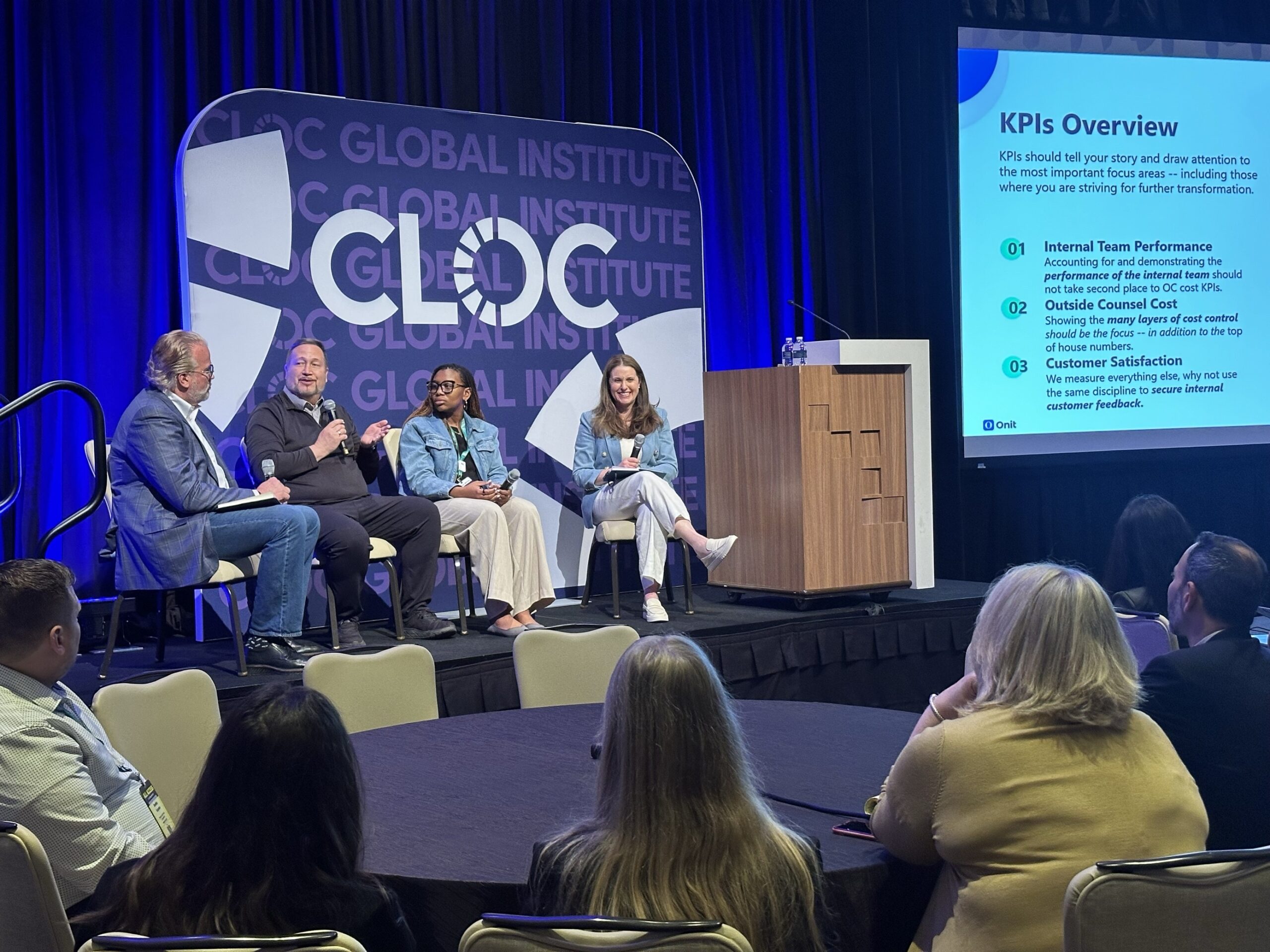Technology drives our modern universe, and it has been proven to galvanize legal departments. However, most legal tech systems—whether enterprise legal management (ELM), contract lifecycle management (CLM), AI, or others—orchestrate processes that also involve business units beyond legal.
At Legalweek 2022, Onit sponsored an emerging technology panel discussion featuring legal operations experts sharing their visions of how self-service technologies and digital transformation have enhanced and advanced their organizational relationships. By doing so—even through navigating the challenges of an increasingly complex regulatory environment and the COVID-19 pandemic—they have facilitated a vital connection to the broader enterprise.
Legal Ops: Initiator of Digital Transformation
Legal departments do not operate in a silo. While it’s no secret that they are well-positioned to operationalize efficiencies, investing in relationships with other departments can have a significant impact on enterprises at large.
“We have moved past the place where legal operations service only the legal department,” explains Jessica Williams, global outside counsel operations manager for Hearst Media Corporation. “Projects that start in legal, such as e-signature programs, often become enterprise-wide.”
Additional projects with cross-departmental span include creating a strategic game plan to deploy AI chatbots and a focus on ELM self-service, which is particularly advantageous for finance departments. Self-service solutions allow users to extract precisely what they need, such as revenue accrual or incurred expense reports, without requiring an administrator’s permission. This frees up time for both parties, a benefit for the business overall.
Corteva Agriscience legal operations leader Gregg McConnell agrees: Fostering relationships outside and across traditional team lines pays off immeasurably. Having spearheaded an enterprise-wide initiative to transition to all-digital documentation at Corteva, McConnell discovered that finance would often approach legal not only for automated reports, but also to identify and quantify the value of new tech.
“Building relationships that create end-to-end transparency across the organization contribute to the core foundation and make an organization bigger, faster and stronger,” McConnell believes.
Championing Projects for “Joe”
Leading in tech introduction while keeping “Joe” in mind—that is, the reluctant adopter of new products or systems, as McConnell says—is the goal. When Corteva found up to 75% of invoices through their ELM cycle had failed, a bulb of wisdom sparked: They needed to speak first to tech skeptics, then build a skillset to accomplish tasks in a simple and constructive manner and present them in a positive light, all while working to solve major pain points.
“Organization synthesizes operations. From a change management perspective, creating comfort and confidence in relationships is key,” says MassMutual business systems consultant Anthony Curzio. “We learned that if info existed somewhere else, customers were imploring, ‘Please do not make us have to key it in again.’” This led from drag and drop functionality to an increasingly more complex data warehouse beyond matter and e-billing.
One transformation initiated by Nick Whitehouse, general manager of Onit’s AI Center of Excellence, was connecting the contract process to the CRM process without creating any additional forms. “Pragmatic as that seems, that paved the way for pace of growth, creating transparency, freeing up time and massively improving the sales process,” notes Whitehouse.
The Art of the Possible
Even the most seemingly miraculous software, however, cannot do all the work: an enterprise requires resources, structure and regular “care and feeding.” This is where the magnitude of relationship cultivation matters most.
“If you automate a broken process, you just get a faster broken process. But taking a longer-term view of strategy and empathizing among teams will develop maturity and trust and ensure efficiency,” says Williams, dedicated to establishing quick automations and delving into predictive analytics for Hearst.
“Disrupting the way legal, finance, and procurement work and automating systems will make things quicker, better, faster and bring a work/life balance back to teams so we can build a real family,” insists McConnell, who is rolling out new ERPs to bring strategic partners together at Corteva. “It’s all about the people.”
Curzio, who pioneered a holistic lean transformation at MassMutual, calls finding the right solution for the time and the ability for legal to partner with finance, IT, service providers and end users the “art of the possible.” Similarly, Whitehouse sees enterprise connections as a servitude to service.
“Every process starts with people, and busy people don’t want to spend time changing things. But when you pose it as, ‘How many six-minute increments will this help you get back in your day? How many hours?’ and find that empirical data, it inspires the journey to build on systems and relationships that become amazingly valuable assets for the entire organization.”
When state-of-the-art user-savvy tools are utilized to amplify how legal ops serve a business, time is saved, never-before-seen financial and data transparency and risk are more effectively managed—and the enterprise becomes more connected as a whole, with the openness, innovation and evolution required for future excellence and success.
To learn more about the impactful role that legal technology plays in enterprise connections, you can explore the capabilities of solutions such as enterprise legal management, contract lifecycle management, and AI.






